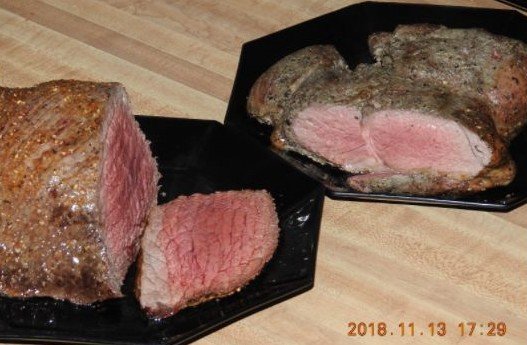INGREDIENTS
This is what you need for 6-8 servings each:
- 1 butterflied leg of lamb, 2 lbs.
- 1 bottom round roast, 2 lbs.
- S&P, spices of choice
DIRECTIONS
- bake uncovered 30 minutes at 350 ºF.
2018-11-15
This was a timing experiment.
I cooked 2 roasts at the same time to get some sandwich meat for the rest of the week. One was a nice little chunk of beef, the other butterflied leg of lamb. Different animals, different shapes, same temperature and cooking time. What will the outcome be?
This is what you need for 6-8 servings each:
 Pic1: two roasts
Pic1: two roasts
 Pic2: the beef roast 15 minutes later
Pic2: the beef roast 15 minutes laterThe experiment turned out pretty good and showed some important factors you need to take into account when cooking a roast.
Left in Pic1 is beef, the other is leg of lamb.
Both were the same weight, about 2 lbs. each. Both were cooked together 30 minutes at 350 ºF.
Pic1 clearly shows the difference in doneness because of the different thickness. The lamb roast was flatter (butterflied) and it is mostly medium; while the rounder beef roast is still quite rare and even slightly undercooked in the center.
Pic2 was taken 20 minutes after the 1st one. Notice that the roast beef now looks medium-done throughout. This is the effect of 'resting' the roast after removing it from the oven. The heat that is trapped inside the roast will continue to cook the roast further.
Notice that—even though the lamb roast was the same thickness throughout—some parts in Pic3 are still quite rare. Those are the pieces right underneath that the layer of fat. A fat layer really delays the cooking progress of the meat directly underneath. For more even cooking throughout, either trim the fat layer back where it is thickest, or cook longer on that side when pan-frying e.g. duck breast.